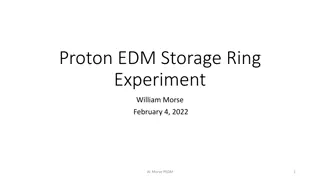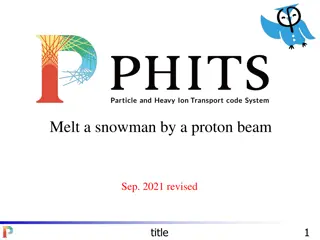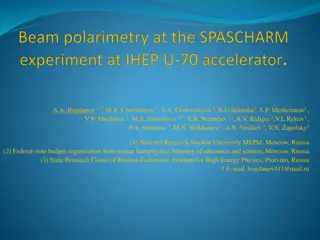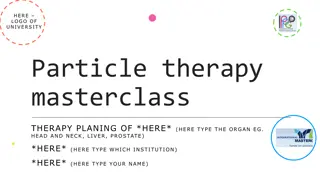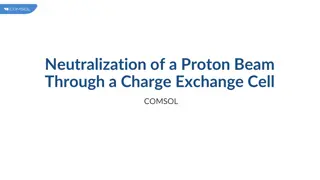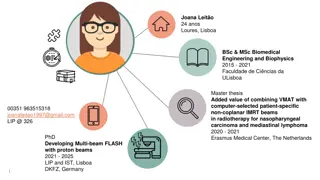Proton Beam Switchyard (BSY) Status Summary - Horizon 2020 Programme
A detailed overview of the Proton Beam Switchyard (BSY) Status funded by the Horizon 2020 programme of the European Union. The aim of BSY is to ensure efficient distribution and focusing of the proton beam onto specific targets. The BSY composition includes various systems like deflecting, focusing, correcting, collimating, and beam dump, with components such as kickers, dipoles, quadrupoles, sextupoles, and more. The BSY Configuration 1 outlines specific requirements for targets, repetition rates, maximum power, and device specifications. Emittance specifications from a meeting at RAL in Jan 2017 are also discussed. The project is led by Elian Bouquerel and emphasizes unique system design with no comparable global system identified as of now.
Download Presentation

Please find below an Image/Link to download the presentation.
The content on the website is provided AS IS for your information and personal use only. It may not be sold, licensed, or shared on other websites without obtaining consent from the author.If you encounter any issues during the download, it is possible that the publisher has removed the file from their server.
You are allowed to download the files provided on this website for personal or commercial use, subject to the condition that they are used lawfully. All files are the property of their respective owners.
The content on the website is provided AS IS for your information and personal use only. It may not be sold, licensed, or shared on other websites without obtaining consent from the author.
E N D
Presentation Transcript
Proton Beam Switchyard (BSY) Status E. Bouquerel Strasbourg, November 07, 2018 Funded by the Horizon 2020 programme of the European Union
Funded by the Horizon 2020 programme of the European Union Aim of the BSY Ensure the distribution and the focussing of the proton beam onto the targets. No similar system appears to exist in the world for such target configuration and beam power Horn/Target Station ESSnuSB layout 2 Elian.Bouquerel@iphc.cnrs.fr
Composition of a BSY Funded by the Horizon 2020 programme of the European Union Deflecting system kickers/pulsed magnets to deflect the protons in the desired trajectory dipoles to compensate angles Focussing system quadrupoles to focus the beam onto the target Correcting system sextupoles to correct eventual achromatic effects in the beam Collimating system to shape the beam before it hits the targets Beam dump (if needed) according to the configuration Diagnostics everywhere that is possible! Primary beam Primary beam Extracted beam from accumulator Deflecting system Deflecting system Beam dump Beam dump Focussing system Focussing system Beam Switchyard Switchyard Beam Correcting system Correcting system Collimating system Collimating system Targets station Targets station 3 Elian.Bouquerel@iphc.cnrs.fr
BSY / configuration 1 Funded by the Horizon 2020 programme of the European Union targets Inputs taken: Repetition rate 14 Hz Type (rms, norm) 25 .mm.mrad = 75 .mm.mrad (un-norm, 3 ) Requirements at target (WP4): = 4 mm (target radius = 15mm) Max. working freq.: 56 Hz Max pulse length 1.32 s Max. power onto target: 1.25 MW 9.2808 T.m collimators Gaussian 3x4 quadrupoles Parameters Max. deflecting angle Magnetic length Max. Magnetic field Type of device Units mrad m T 94 2 < 0.50 Classical 6 conventional dipoles Total intensity, NI (per pole) 18 kA. turns x not at scale 1st and 2nd dipoles work at a freq. of (rep.rate / 2) y T1 axis 4 Elian.Bouquerel@iphc.cnrs.fr
Funded by the Horizon 2020 programme of the European Union Emittance spec, meeting at RAL, Jan 2017 = 2.967 for 2 GeV E. Wildner, Status report from WP3.
BSY / configuration 1 Funded by the Horizon 2020 programme of the European Union targets Inputs taken: Repetition rate 14 Hz Type (rms, norm) 25 .mm.mrad = 75 .mm.mrad (un-norm, 3 ) Requirements at target (WP4): = 4 mm (target radius = 15mm) Max. working freq.: 56 Hz Max pulse length 1.32 s Max. power onto target: 1.25 MW 9.2808 T.m collimators Gaussian 3x4 quadrupoles Parameters Max. deflecting angle Magnetic length Max. Magnetic field Type of device Units mrad m T 94 2 < 0.50 Classical 6 conventional dipoles Total intensity, NI (per pole) 18 kA. turns x not at scale 1st and 2nd dipoles work at a freq. of (rep.rate / 2) y T1 axis 6 Elian.Bouquerel@iphc.cnrs.fr
BSY / configuration 1 Funded by the Horizon 2020 programme of the European Union Advantages Compact system, Short length <50 m, Only one triplet needed on each branch of the BSY, Realistic fields of the magnets. Disadvantages The protons deflected by the first pulsed dipole go towards the second one. This implies this magnet having a consequent vertical aperture and therefore leading to a certain impact on its inductance, Main constraint Emittance of the beam from the accumulator > 25 .mm.mrad (rms, norm) Find places for steerers and diagnostics (and potential sextupoles?) Need to think of another configuration! not at scale 7 Elian.Bouquerel@iphc.cnrs.fr
BSY / Alternative configuration Funded by the Horizon 2020 programme of the European Union Inputs taken: Repetition rate 14 Hz Type (rms, norm) 25 .mm.mrad = 75 .mm.mrad (un-norm, 3 ) Requirements at target: = 4 mm (target radius = 15mm) Max. working freq: 56 Hz Max pulse length: 1.32 s Max. power onto target: 1.25 MW 9.2808 T.m Gaussian Parameters Max. deflecting angle Magnetic length Max. Magnetic field Type of device Units mrad m T 343 3 > 1.0 Classical 6 conventional dipoles Total intensity, NI (per pole) 99.5 kA. turns Primary Primary beam beam 1st dipole works at a freq. of (rep.rate / 2), the others at rep. rate / 4 T4 T4 T1 T1 p 2 GeV, 5 MW, p 2 GeV, 5 MW, 70 Hz 70 Hz T3 axis T2 T2 x T3 T3 14Hz dipoles dipoles quad quad dipoles dipoles quad quad col col Targets Targets Ongoing simulations done with (rms, norm) 35 .mm.mrad (=105 .mm.mrad, un-norm, 3 ) does not seem to be impossible not at scale y 8 Elian.Bouquerel@iphc.cnrs.fr
BSY / Alternative configuration Funded by the Horizon 2020 programme of the European Union Advantages No constraints on the vertical aperture of a second dipole, Enough place for other devices (diagnostics, steerers etc), Can accept higher beam emittance (?), Disadvantages Longer than the one of config. 1 (but is it too long??) the target station can have from the accumulator? Question: What max. distance Less compact, Having more magnets increase the probability of failure, not at scale 9 Elian.Bouquerel@iphc.cnrs.fr
BSY / to be done & info needed Funded by the Horizon 2020 programme of the European Union Info needed: Twiss parameters (+dp/p) of the beam extracted from the accumulator, In case of higher pulse freq. from the accumulator: Need to look for other technology for the magnets rather than conventional ones, To be investigated: Increase further the emittance acceptance of the BSY, Feasibility of the magnets for the alternative configuration, Achromaticity of the beam, Design of the collimators, Position, Numbers and definition of diagnostics.. 10
Funded by the Horizon 2020 programme of the European Union Thank you for your attention!
Funded by the Horizon 2020 programme of the European Union I is the intensity applied per coil (A), VAP is the vertical aperture of the magnet (m), B is the magnetic field (T), 0is the permeability of free space (4 x10-7 Vs/Am), N is the number of turns (coils) B V = AP I N 0 ( ) 2 N H L is the inductance (H), = L 0 AP HAP is the horizontal aperture of the magnet (m). V AP If EMITTANCE thus VAP thus L Two limitations here: - Inductance should be less than 5-10 H Because of the maximum current ramp rate dI/dt that can t reach high values: - Increase the aperture of magnets decreases the quality of the magnetic field generated. Why not increasing the number of coils (N) then to increase L value? - Intensities of more than 40 kA turns (NI) per pole are hardly achievable (?) Then we could decrease the deflection angles of the dipoles BUT this would extend the beamline = addition of more quadrupoles to manage the beam (as big beam divergence) (order of magnitude currently reached) dI = + VTOT RI L dt 12 Elian.Bouquerel@iphc.cnrs.fr






